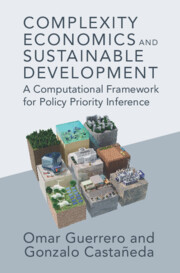Refine search
Actions for selected content:
2860 results in Computing and Society
7 - Government Spending and Structural Bottlenecks
- from Part II - A Global View of Sustainable Development
-
- Book:
- Complexity Economics and Sustainable Development
- Published online:
- 04 January 2024
- Print publication:
- 25 January 2024, pp 188-206
-
- Chapter
-
- You have access
- Open access
- Export citation
Foreword
-
- Book:
- Complexity Economics and Sustainable Development
- Published online:
- 04 January 2024
- Print publication:
- 25 January 2024, pp xvii-xxii
-
- Chapter
-
- You have access
- Open access
- Export citation
6 - The Feasibility of the Sustainable Development Goals
- from Part II - A Global View of Sustainable Development
-
- Book:
- Complexity Economics and Sustainable Development
- Published online:
- 04 January 2024
- Print publication:
- 25 January 2024, pp 167-187
-
- Chapter
-
- You have access
- Open access
- Export citation
8 - Public Governance and Sustainable Development
- from Part II - A Global View of Sustainable Development
-
- Book:
- Complexity Economics and Sustainable Development
- Published online:
- 04 January 2024
- Print publication:
- 25 January 2024, pp 207-230
-
- Chapter
-
- You have access
- Open access
- Export citation
Part III - A Focalised View of Sustainable Development
-
- Book:
- Complexity Economics and Sustainable Development
- Published online:
- 04 January 2024
- Print publication:
- 25 January 2024, pp 263-264
-
- Chapter
-
- You have access
- Open access
- Export citation
Abbreviations
-
- Book:
- Complexity Economics and Sustainable Development
- Published online:
- 04 January 2024
- Print publication:
- 25 January 2024, pp xxv-xxvi
-
- Chapter
-
- You have access
- Open access
- Export citation
Acknowledgments
-
- Book:
- Complexity Economics and Sustainable Development
- Published online:
- 04 January 2024
- Print publication:
- 25 January 2024, pp xxiii-xxiv
-
- Chapter
-
- You have access
- Open access
- Export citation
13 - Lessons and Reflections
- from Part III - A Focalised View of Sustainable Development
-
- Book:
- Complexity Economics and Sustainable Development
- Published online:
- 04 January 2024
- Print publication:
- 25 January 2024, pp 350-369
-
- Chapter
-
- You have access
- Open access
- Export citation
Index
-
- Book:
- Complexity Economics and Sustainable Development
- Published online:
- 04 January 2024
- Print publication:
- 25 January 2024, pp 390-392
-
- Chapter
-
- You have access
- Open access
- Export citation
12 - Deprivation, Income Shocks, and Remittances
- from Part III - A Focalised View of Sustainable Development
-
- Book:
- Complexity Economics and Sustainable Development
- Published online:
- 04 January 2024
- Print publication:
- 25 January 2024, pp 323-349
-
- Chapter
-
- You have access
- Open access
- Export citation
11 - Accelerators and Systemic Bottlenecks
- from Part III - A Focalised View of Sustainable Development
-
- Book:
- Complexity Economics and Sustainable Development
- Published online:
- 04 January 2024
- Print publication:
- 25 January 2024, pp 289-322
-
- Chapter
-
- You have access
- Open access
- Export citation
Bibliography
-
- Book:
- Complexity Economics and Sustainable Development
- Published online:
- 04 January 2024
- Print publication:
- 25 January 2024, pp 370-389
-
- Chapter
-
- You have access
- Open access
- Export citation
10 - Subnational Development and Fiscal Federalism
- from Part III - A Focalised View of Sustainable Development
-
- Book:
- Complexity Economics and Sustainable Development
- Published online:
- 04 January 2024
- Print publication:
- 25 January 2024, pp 265-288
-
- Chapter
-
- You have access
- Open access
- Export citation
3 - Relevant Data and Empirical Challenges
- from Part I - A Complexity Approach to Sustainable Development
-
- Book:
- Complexity Economics and Sustainable Development
- Published online:
- 04 January 2024
- Print publication:
- 25 January 2024, pp 53-103
-
- Chapter
-
- You have access
- Open access
- Export citation
Part I - A Complexity Approach to Sustainable Development
-
- Book:
- Complexity Economics and Sustainable Development
- Published online:
- 04 January 2024
- Print publication:
- 25 January 2024, pp 1-2
-
- Chapter
-
- You have access
- Open access
- Export citation

Complexity Economics and Sustainable Development
- A Computational Framework for Policy Priority Inference
-
- Published online:
- 04 January 2024
- Print publication:
- 25 January 2024
-
- Book
-
- You have access
- Open access
- Export citation
6 - Plural Agonistics
-
-
- Book:
- Information Literacy through Theory
- Published by:
- Facet
- Published online:
- 26 March 2024
- Print publication:
- 07 December 2023, pp 91-110
-
- Chapter
- Export citation
11 - Variation Theory: Researching Information Literacy Through the Lens of Learning
-
-
- Book:
- Information Literacy through Theory
- Published by:
- Facet
- Published online:
- 26 March 2024
- Print publication:
- 07 December 2023, pp 183-196
-
- Chapter
- Export citation
Index
-
- Book:
- Information Literacy through Theory
- Published by:
- Facet
- Published online:
- 26 March 2024
- Print publication:
- 07 December 2023, pp 241-245
-
- Chapter
- Export citation
3 - Information Literacy in a Nexus of Practice: A Mediated Discourse Perspective
-
-
- Book:
- Information Literacy through Theory
- Published by:
- Facet
- Published online:
- 26 March 2024
- Print publication:
- 07 December 2023, pp 39-56
-
- Chapter
- Export citation
